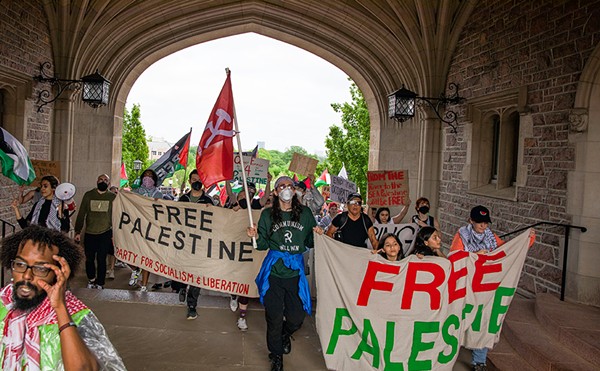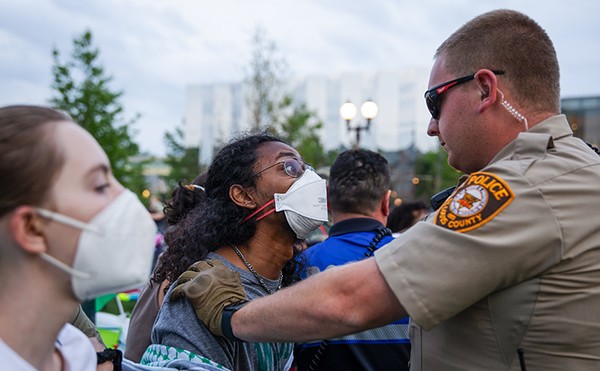Around the same time, a more unusual nuisance had also emerged -- the 71-year-old, nine-story bank building at one of the city's busiest intersections was attracting attention. By the count of the city's street division, 48,042 cars pass the bank every weekday. Sure, they see the imposing structure, but many probably don't know what's in it. To most, it's an isolated landmark. Across Grand, the Schweig-Engel outlet is empty, though the closing of the furniture-and-appliance business that calls itself the "King of Credit" could be argued as a good sign for the block. But there are other empty storefronts; even Pizza A-Go-Go has gone. On the upside, across Gravois Avenue, White Castle bothered to rebuild, this time with two drive-throughs.
A bit farther north on Grand Boulevard, numerous ethnic restaurants, coffeehouses and shops had sprung up, creating a buzz of positive PR about the possibilities of city living in the South Grand district. A few blocks to the south, the long-empty Sears Building had been demolished for new houses, many pre-sold for upwards of $140,000. In December, the International Institute had moved into its remodeled headquarters nearby, providing a focus for the estimated 35,000 new immigrants who live in the city. But between the two beehives of boom, the South Side National Bank Building lay quiet, somewhat neglected.
But then Walgreens, the drugstore company that has seldom seen a street corner it didn't like, came onto the scene. Interest expressed by Walgreens, through a developer, woke up the neighborhood. Under the proposal, Walgreens would build a new store on the corner of Grand and Gravois, and the bank would open a new branch, once the current building was demolished. South Side National Bank president Tom Teschner insists nothing was ever put in writing and that "technically" there never has been an offer involving Walgreens "on the table."
What's on the table now is a feasibility study prompted by last fall's controversy over Walgreens' replacing the nine-story landmark. Ald. Marge Vining (D-15th) funneled $15,000 of federal block-grant money to a study to see what could be done with the bank building. The study, performed by the Siedlund Co., recommends that the seven-story tower of the building be renovated into apartments with rents ranging from $850-$1,000 for 1,063-square-foot units. Putting offices back in the tower also is proposed, but the study states that most offices want more space than each floor has. The study presents five options, each with financial analysis, each with the need for "gap financing." There's the rub.
After accounting for investment from the developer and monies from state and federal tax credits, it looks as if the "gap" must be made up from some governmental source, most likely City Hall. Depending on the option, the gaps range from $543,140 to $1.8 million. South Side National Bank could partner with a developer and facilitate the financing. Vining thinks it's time for the bank's Teschner to look at the study and see what the bank is willing to do.
"The ball is in his court," says Vining. "We've done the feasibility study. He has to look it over, talk to his board, and they have to come back and say what they're going to do."
Teschner sees it a bit differently. He thinks the next move is City Hall's.
"What I'm waiting for is to see what the interest level is of the city to provide gap financing," says Teschner. "If the interest level of the city is not to do that, then they've pretty much signed off that this doesn't work financially." A spokesman for Mayor Clarence Harmon says the mayor's office is looking into the feasibility study.
If the city doesn't help close that gap, then Teschner plans to go ahead with the developer's plan for a shiny new Walgreens and a new, much smaller and less noticeable bank building at the corner. "It would only make sense to move forward with doing a plan that brings two new buildings to the city," Teschner says. "I would think we would get the cooperation of the city to make that happen, if that's the general plan we want to do."
If the numbers don't add in favor of renovating the bank building, Vining says, Teschner will have a hard time getting the tower demolished. If the bank's request for demolition were turned down by the preservation board, then it would face the planning commission. If the commission said no, the case would move on to the courts. "No administration is going to give him a demolition permit, especially now that the community wants to keep the bank," says Vining. That's not to say that, after much maneuvering and suing, the building wouldn't come down. Vining, and those in the area who pushed the alderwoman to block the demolition, want to save the building.
"If Tom Teschner wants to sell that building, he can sell it. We're not objecting to that; we're objecting to him, or anybody, tearing it down and destroying that landmark," says Vining, who is optimistic that something can be worked out with the city, although it may not be easy. "All the money is going downtown. You really have to scratch and scream to get any money in the neighborhoods."
Vining also doesn't see why Walgreens can't adjust by moving into the current structure.
"Walgreens has done this in Chicago. They've gone into some of these older buildings and retrofitted the building for Walgreens. They're doing that all over. But for some reason, their mindset in the city of St. Louis is, 'We're not going to do that.'" The Walgreens at Gravois and Gustine Avenue was going to be closed and relocated to the bank site, but if that move is blocked, it could further complicate the planned demolition of the Walgreens and Kmart at the Gravois Plaza site for a new Shop 'N Save, because the current Walgreens would not have a new location.
With the feasibility study for South Side Bank in hand and conflict looming, proponents of redoing the bank tower as apartments plan a community forum on Thursday, July 20, at St. Pius V Church at South Grand and Utah. The same type of coalition-building of neighborhood forces that resulted in the public furor and apparent blockage of a Kmart at Chippewa Street and Kingshighway appears to be in the early stages with South Side National Bank.
Teschner sees significant differences between the two situations: With regard to the Kmart impasse, the lot where the Southtown Famous-Barr used to stand has been vacant for six years. At Grand and Gravois, either the building will be renovated or, as Teschner sees it, in its place will be built a new Walgreens and a new bank building. Teschner says he wants to avoid "the community getting in an uproar," but that will take cooperation "from both sides" to accomplish.
"If you've that cooperation, then I wouldn't think it would get ugly," says Teschner. "But there's a lot of conversation out there. When you have people stating their opinions that nothing is good unless that building stays, then they've closed their eyes to anything that could potentially move this forward in a positive light. If they want to throw up the roadblocks to say, 'We're saving this building no matter what anybody says,' then you've got a sad state of affairs."
From the bank's viewpoint, a renovation of the bank tower into apartments would have to make economic sense. "Saving the building is an option, but everybody has to see and understand the economics of it. If the economics of it are that the city has to help or assist with what this gap financing might be, then that's their commitment to save the building, as well as our commitment to stay there and make the thing work."
Teschner's statements are tinged with defensiveness; he says it was his intent from the beginning to include the city and the community in his plans: "What's unfortunate is, when this whole issue started, if it was South Side's intention to just not care about the building, we would have worked out a deal, worked out an arrangement, torn down the building, built what was new, and we wouldn't have had this issue other than getting the public outcry about what we did. It was my intention to include the city on this."
In the eyes of the forces forming to save South Side, demolition would mean defeat.
Teschner sees it differently, with either option a plus. A renovated tower would mean new apartments and a spruced-up building; demolition would mean new construction.
"If Walgreens is building a brand-new building, and we're building a brand-new bank, and there's brand-new homes going up down the street, all of that, I think, lends support to the regrowth and stabilization of that community," Teschner says.
Whatever the trigger, Ald. Craig Schmid (D-10th) sees the flashpoint of the bank controversy as starting a brushfire of activism spreading from the Southtown situation and the Sears demolition to other issues. "It's not just a smaller group focused in on one thing. We now have a larger coalition," says Schmid. "It's connecting; it's networking. This is what cities are all about. This is how communities operate. It used to be over the back fence. A lot of that still happens, but now you have the sophistication of Metropolis, the Internet efforts and community meetings."
Related Links:
www.south-grand.com





